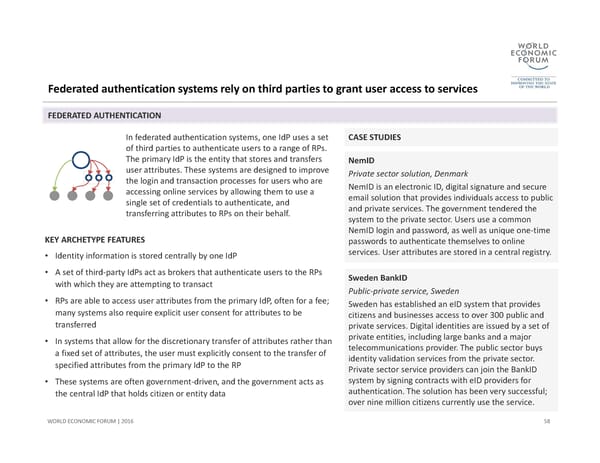Sweden BankID Public‐private service, Sweden Sweden has established an eID system that provides citizens and businesses access to over 300 public and private services. Digital identities are issued by a set of private entities, including large banks and a major telecommunications provider. The public sector buys identity validation services from the private sector. Private sector service providers can join the BankID system by signing contracts with eID providers for authentication. The solution has been very successful; over nine million citizens currently use the service. Federated authentication systems rely on third parties to grant user access to services 58 WORLD ECONOMIC FORUM | 2016 KEY ARCHETYPE FEATURES •Identity information is stored centrally by one IdP •A set of third‐party IdPs act as brokers that authenticate users to the RPs with which they are attempting to transact •RPs are able to access user attributes from the primary IdP, often for a fee; many systems also require explicit user consent for attributes to be transferred •In systems that allow for the discretionary transfer of attributes rather than a fixed set of attributes, the user must explicitly consent to the transfer of specified attributes from the primary IdP to the RP •These systems are often government‐driven, and the government acts as the central IdP that holds citizen or entity data In federated authentication systems, one IdP uses a set of third parties to authenticate users to a range of RPs. The primary IdP is the entity that stores and transfers user attributes. These systems are designed to improve the login and transaction processes for users who are accessing online services by allowing them to use a single set of credentials to authenticate, and transferring attributes to RPs on their behalf. FEDERATED AUTHENTICATION CASE STUDIESNemID Private sector solution, Denmark NemID is an electronic ID, digital signature and secure email solution that provides individuals access to public and private services. The government tendered the system to the private sector. Users use a common NemID login and password, as well as unique one‐time passwords to authenticate themselves to online services. User attributes are stored in a central registry.
 A Blueprint for Digital Identity Page 58 Page 60
A Blueprint for Digital Identity Page 58 Page 60